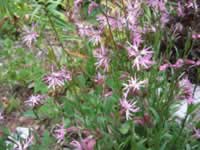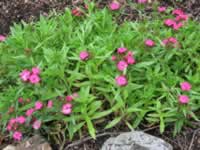Dianthus Plants
How to Grow and Care for Carnations, Pinks and Sweet Williams
       
Dianthus means divine flower
There are over 300 species of Dianthus, as well as hundreds of beautiful hybrids
Dianthus Plants produce richly fragrant flowers in the spring or summer,
sometimes extending right up until the first frost!
The Dianthus genus includes annuals, biennials and perennials
that are commonly known as Carnations, Pinks or Sweet Williams.
Most garden varieties of Dianthus plants grow from 10 to 20 inches tall,
however some species can vary from 2 inches to 3 feet tall in height.
Growing Requirements for Dianthus Plants |

|
Dianthus grow and bloom best in cooler climates.
They should be grown in a spot where they will receive at least 4-5 hours of full sun each day.
They should be planted in fertile, fast draining, slightly alkaline (pH 6.75) soil.
Dianthus plants require good air circulation around the stems at all times
and must be kept as free from lingering moisture as possible.
Avoid over-watering Dianthus because it may tend to turn their foliage yellow.
Usually a weekly watering of established plants will suffice unless the weather is extremely dry.
Plant Dianthus 12" 18" apart and at the same depth at which they were previously growing.
The crown (top of the root structure) of Dianthus plants
must be planted level with the surface of the soil.
Never bury any part of the stems.
Unlike most other plants, Dianthus plants should not be mulched.
|
|
Spent flowers should be removed promptly to promote continued blooming.
Dianthus will often reseed themselves, so don't be too hasty in removing spent plants from the ground.
For continued blooming feed lightly every 6 to 8 weeks with an all-purpose (10-10-10) liquid fertilizer.
Growing Dianthus Plants from Seed
You can start Dianthus seeds indoors 6 to 8 weeks before the
last frost is expected for spring planting and blooms during the first year.
If you prefer, you can sow the seeds directly into a sunny location
in the garden in the spring or early in the summer.
Plant your seeds 1/8" deep in light, well-drained soil.
Firm the soil over your seeds and keep it moist until the plants
are sprouted and have begun growing vigorously.
Plants from seeds sown in the garden will probably not flower
until the following year. |
|
Propagating Dianthus by Cuttings, Layering or Division
Perennial varieties of Dianthus can be propagated by tip cuttings, layering and division
Softwood tip cuttings taken from your Dianthus plants in the spring or in early summer
will be ready to be planted in the garden by fall.
However, plants grown from cuttings will not flower until the following year.
Dianthus are easily propagated by digging and dividing established clumps.
Dividing your Dianthus plant has the additional benefit of rejuvenating older, non productive clumps.
Dig up an entire Dianthus clump and either pull it apart using your hands to separate the plant segments.
You can also use two gardening forks inserted in the center of the clump to gently pry the plant apart.
Replant each new division as you would a new perennial or annual, and water it in very well.
Tip layering is another easy way to propagate new Dianthus plants
Simply pin or peg a growing tip of your plant to the ground
and wait for the roots to develop before severing the new plant from the mother plant.
Dianthus Plants

Carnation
Dianthus x caryophyllus |

Garden Pink
Dianthus superbus |

Sweet William
Dianthus barbatus |
|
|
|
Search The Garden Helper:



